Without a clear strategy, hotel digital marketing is doomed to generate poor outcomes and spending more money.
But don’t freak out.
You don’t need a two-hundred-page document for that, nor do you need to spend a lot of money on something that would only fill up your drawer. We will demonstrate how to create an absurdly basic yet incredibly effective marketing strategy.
A simple method will save your money while increasing the effectiveness of digital marketing initiatives.
With the right plan, you’ll always know what to post on Facebook, which PPC campaigns to set up, and whom to send email campaigns to… Everything is already in place, and all you have to do is follow the directions — no guesswork and no wasted resources.
We will show how to develop efficient hotel marketing strategies using a model that we have successfully applied to dozens of hotel facilities and other clients.
Why are hotel marketing strategies important?
Many companies fall into digital marketing without any planning. It usually starts with “Let’s try Instagram” or “Let’s run a Facebook ad for this special offer”. Before you even notice, digital has become your daily activity but without any planning and strategic thinking.
When we take over a new client, we start with really simple, but super effective strategy. We like to keep it simple. Sometimes is just a diagram, a drawing or a few pages document. Then, we present that plan to the client and adopt suggestions. We don’t start our work without resolving all questions and details within the strategy.
So, we do not start with regular digital marketing activities without a pre-setting marketing strategy. That says enough about its importance.
The hotel’s digital marketing strategy is the framework for all marketing activities – Facebook and Google campaigns, social media management, website copy, etc.
The strategy will identify specific business goals, determine the target group of guests and provide a framework for where, when, and how messages will be placed to these people to become (loyal) hotel guests.
Even if you have an external agency taking care of a hotel’s digital marketing for you, they should work by following a simple strategy that you are familiar with. That will make it much easier for you to monitor their work and measure the results of all activities.
Should you spend time creating a digital marketing strategy?
Of course, and here’s why. If you immediately start implementing marketing activities, you will quickly get into the crazy rhythm of daily tasks – posting on Instagram and Facebook pages, running ads, communicating with followers, and ultimately losing track of what, how, and for what purpose you are doing all this.
We know because it happened to us too.
You begin to create Instagram posts just for the sake of posting, you create campaigns without even knowing who to target or what to write in the ad copy, and you waste your time and money in vain.
The marketing strategy will organize all these activities and direct them towards achieving business goals with significant savings.
There is no ideal strategy, and therefore it must be subject to change. You will see what turned out to be good in that strategy, what needs to be adjusted, and what needs to be changed completely. The process is called sales funnel optimization.
The first step in hotel digita1 marketing strategy: Do your market research
You can’t start working on your hotel’s digital marketing strategy without a proper research. Assuming you already know everything there is to know about your property, you need also gather information on your competitors, market conditions, prices, demand volume, and so on.
Only the greatest industry players could afford detailed tourism market research a few decades ago, but now you can do it yourself!
Thanks to Internet you can do a decent travel market research on your own with available and FREE TOOLS that can be found online. For more information, see our article on How to do travel market research.
Step 2: Designing a sales funnel
The sales funnel represents the foundation of the hotel’s digital marketing strategy, and by defining the sales funnel, you already have a draft strategy that you can follow.
To define a sales funnel, we must first understand the stages in the guest’s cycle and the guest warming concept.
The guest cycle is a set of phases that the guest goes through before, during, and after his trip. There are several variants, but, in essence, it looks like this:
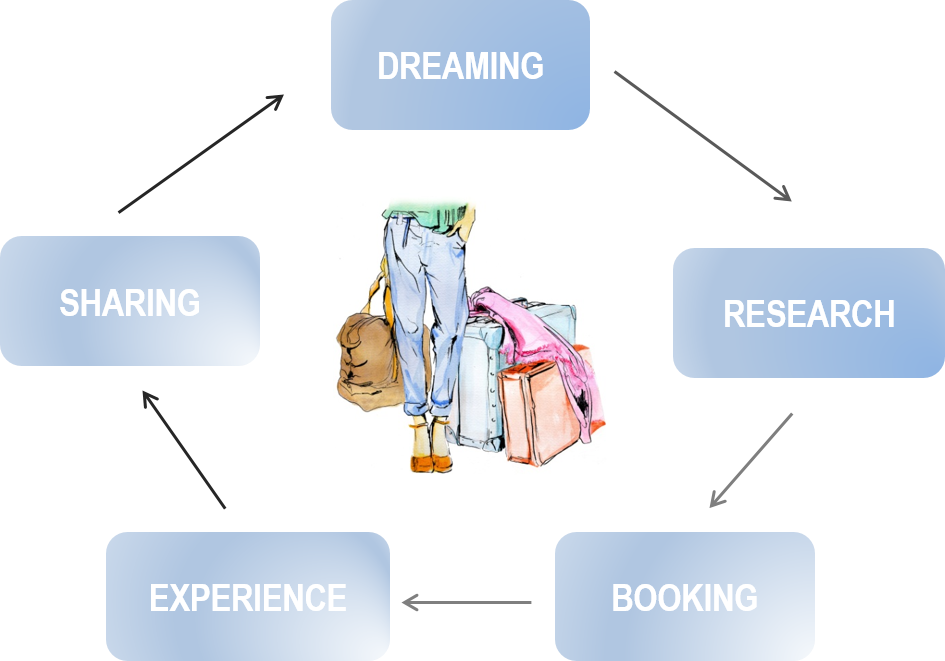
Each of these phases is very important,. Therefore, it is essential that the strategy defines marketing activities and especially the tone of communication and messages sent to guests in each phase.
Hotel marketers often forget that it is necessary to warm up the guests before selling to them. It is a big mistake to assume that everyone who visits the hotel’s website, watches a YouTube video, or clicks on a Facebook ad is highly interested in staying at the hotel.
Just because they saw a beautiful photo of the hotel on Instagram, clicked on the ad, and came to the website does not mean that they will book or are even interested in booking.
That’s why we must first pre-heat the guests to show the booking ads only to those who are highly interested in booking our hotel.
With all this in mind, we should design a sales funnel that marks all the steps in the guest cycle process – from the moment they hear about our hotel for the first time to the final reservation (and repeated revisit).
In theory, the hotel funnel looks like this:
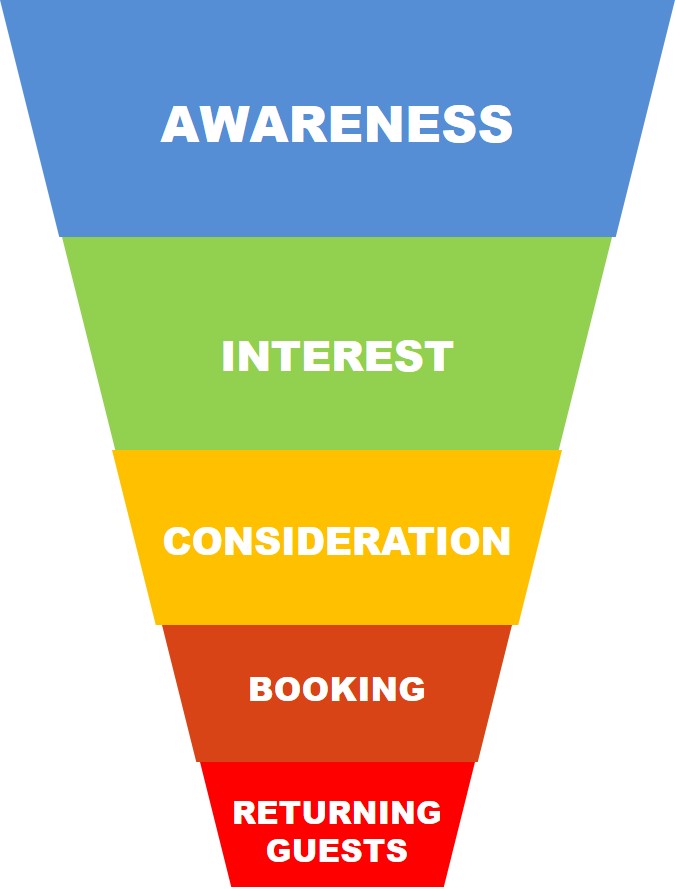
You can immediately notice where the name “funnel” comes from. The funnel is widest at the top and then narrows towards the bottom. At the very top of the funnel is the “Awareness” phase which includes those who heard about the hotel. But, the fact that they heard of the hotel does not mean that they are interested in booking it. That is why this phase has a blue color, which symbolizes a cold audience.
There is a smaller number of those who are interested in hotel services. They will show their interest by leaving measurable digital footprints, i.e., interaction with the hotel website and PPC ads. The goal is to move as many of them as possible to the next phase. Things are getting warmer here…
Those who reach the consideration stage are already choosing between several hotels and are one step away from a decision. Therefore, the hotel marketing team needs to be competent at this phase and convert those worm visits into bookings, which is usually the last phase in the sales funnel.
However, in real life, the sales funnel always looks completely different. It usually looks like this:
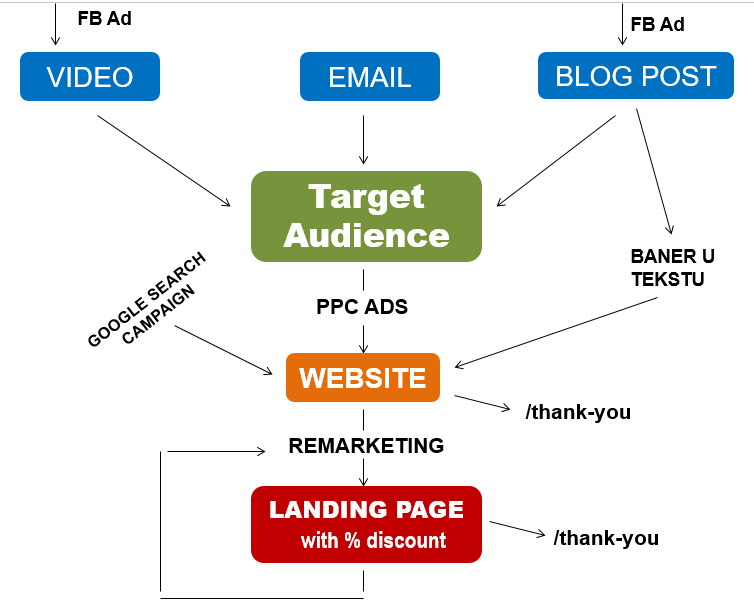
But more often, funnels that we create are similar to this one:
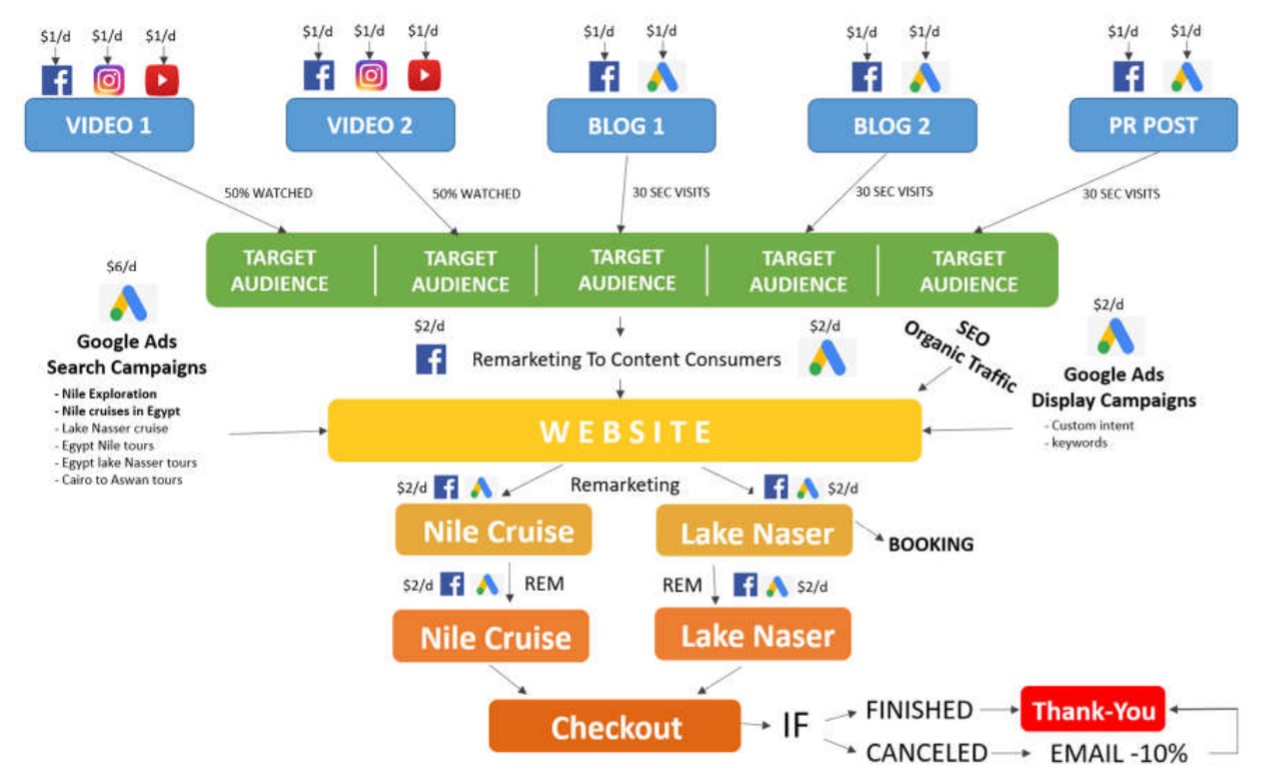
As shown in the picture above (an example is our client from Egypt), the funnel has additional information. However, it already represents a draft of a digital marketing strategy that other hotels usually don’t have.
Step 3: Defining the hotel’s target audience
The target group comprises potential guests with specific common characteristics and similarities that complement the hotel’s offer. It includes ideal guests for the hotel and is more valuable than the general population.
The hotel will usually have several target groups whose wishes and characteristics match the offer and capacities of the hotel.
Why is it essential to determine the hotel’s target groups?
Hotels that try to reach a wider population will not be able to highlight all the advantages of the hotel and communicate to guests in the right way.
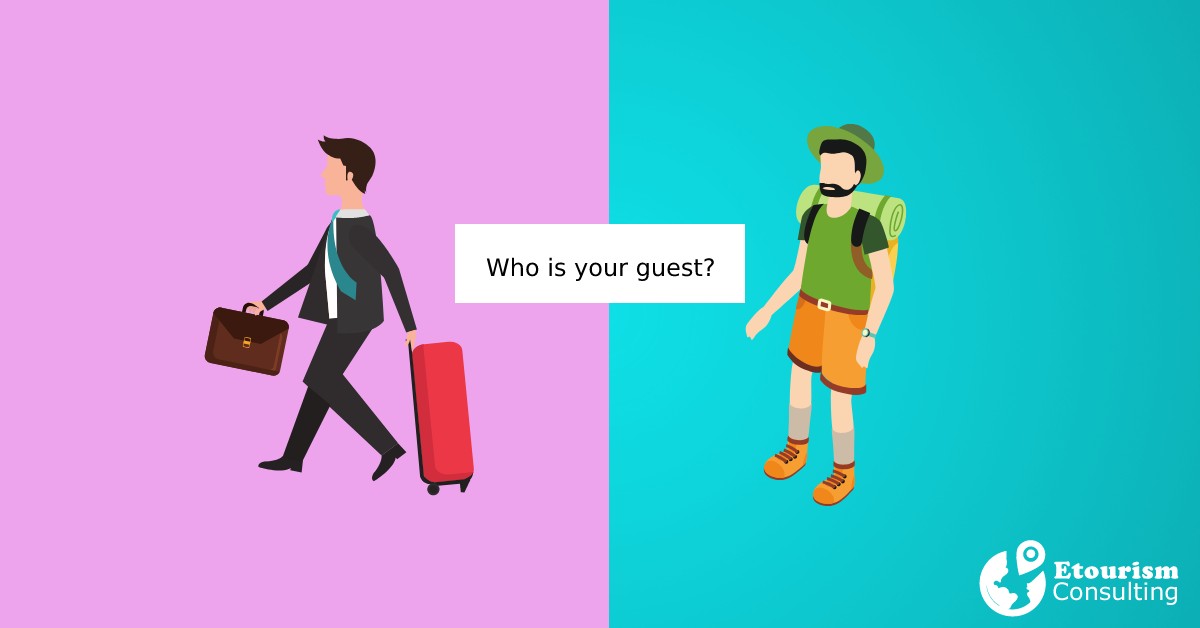
Imagine that families with children come to the hotel, but because of the business and congress center nearby, business people often choose it as well.
These two groups of guests have entirely different needs, desires, and fears when choosing a hotel. For example, while parents are interested in facilities for children, such as a playroom, animators, a baby cot, discounts for children, etc., business people are not interested in that at all. On the contrary, they are interested in high-speed internet, laundry and ironing services, fast check-in and check-out, the possibility of using the meeting room, photocopier, etc.
If the hotel ignores the existence of these market segments, its marketing will be sluggish, monotonous and unconvincing, and often wrong.
Focusing on a specific market segment provides exceptional communication and marketing opportunities. You can tailor prices, promotional messages, promotion channels, and even the product itself to some extent (although this is harder to do in tourism due to the inflexibility of the offer) to your ideal guests.
It would be ideal to determine the hotel’s target audience even before the facility’s construction, based on the type of destination, attractions, and localities nearby, tourist demand, and other factors. In that case, hotel investors can adjust the offer to the target market segments. We had the opportunity to participate as consultants in several such projects. Each of them was later quite successful precisely because of the time thinking about the target group of guests.
However, this is often not the case, so the target group is determined later, based on all the mentioned criteria, taking into account the hotel offer and the capacity of the facility itself.
Step 4: Defining the hotel USP
All hotels offer the same service – a place to stay, eat and sleep. These services are very similar in every hotel and, unfortunately, more and more hotels’ appearance resemble each other.
That is why it is crucial to find what is unique for your hotel and understand what is the most important to your target group. This is called Unique Selling Proposition or USP.
The USP is usually in the form of a single sentence, preferably as short as possible, but it can also consist of several sentences. The USP emphasizes the competitive advantages of hotels in relation to competing facilities, whether it is a better location, better quality, lower price, or something completely different.
A good USP will immediately tell guests why this hotel is the best choice for them. However, such USP cannot be created without properly defined target groups, conducted market analysis, and a detailed analysis of the facility itself.
In practice, it is sporadic to see that hotels have a defined USP at all, and even in those rare cases, they are usually boiled down to some witty and funny slogans. But, the truth is:
Witty slogans don’t sell!
When creating a USP, you do not have to be creative. It is enough to briefly point out what makes your hotel property unique and why it is the best choice for your target group. It would be just fine to say:
Hotel with a private sandy beach with All-inclusive service based on organic food with many facilities for children.
This kind of USP is not creative at all, and it could certainly be much better, but it is enough to read it once, and you will immediately know who the target group of this hotel is. These are wealthier families with children, and this USP directly affects what is most important to them and thus becomes their primary choice. They care about the health of their children (organic food), comfort, convenience, without crowds (private beach), and most of all, they care about whether the children won’t be bored during their stay (facilities for children).
This kind of USP has already finished more than half of the sales towards this target group, while some creative slogans would probably go unnoticed.
Having the right USP will make your job enormously easier when creating promotional messages and PPC ads. Here are just a few examples:
- What to put in a Google Ad description? Let’s go with the USP!
- What to write for a Facebook remarketing ad? Let’s insert the USP and adjust it a bit.
- We rented some billboards, but what should we write on them? We’ll go with the USP!
- What to write as a meta-description for the hotel’s website homepage? Well, of course – USP!
And there are many more examples of USP usage on a daily basis.
Step 5: Creating the content for each stage of the sales funnel
When defining the digital path that a guest takes from the moment they hear about the hotel until they make the booking, it is necessary to determine the type of content and tone of communication with guests at each funnel stage.
Will you show the same ad to those who have not even heard of the hotel and to those who are just one step away from booking?
Of course not.
Fortunately, digital marketing has given us the ability to easily identify at what stage a guest is currently in and, depending on that, place a customized message that is ideal at a given time.
For those who have not heard of the hotel, the information that you are offering a 25% discount this weekend will not mean much because they are not interested in such an offer at a given moment. However, such a message will be perfect for people who are already close to the reservation and need only a little “push” and motivation.
Step 6: Define your SEO strategy and win in the long run!
Even if your website is well-designed and well-functioning, it won’t generate bookings unless you figure out how to get people to see it.
In addition to paid advertising on Facebook and Google, your hotel’s own website may bring in a large number of free visitors each month. In addition, visitors are more likely to convert when they arrive via Google’s organic search results.
This is where search engine optimization (SEO) comes in! But don’t get your hopes up too high! SEO is for the distance runners. This is why you should abstain from expecting immediate results from your SEO expert or agency; it’s just not realistic.
Anyone who guarantees that your website will be at the top of Google’s search results in a matter of weeks is not to be trusted. For this reason, your hotel SEO approach should be centered on implementing long-term best hotel-specific SEO practices in order to reap the benefits of your efforts.
Step 7: Choose your platforms, tools and define budgets
After all the above, you need to define the overall marketing budget, allocate it to each segment of the strategy, delegate responsibilities, find tools to help you do it all, monitor everything, and constantly optimize your campaigns and system as a whole.
You’ll need to set up your Facebook Ads account, Google Ads account, or Bing and Twitter ads, depending on your marketing funnel. Setting up Google Analytics with defined goals, measurable KPIs, and all tracking in place is a must-have. This will allow you to monitor the efficacy of the middle and bottom stages of your marketing funnel and make adjustments as needed.
A Google Tag Manager is a valuable tool for setting up extensive tracking for hotel websites. We certainly make extensive use of it.
Then there are many other tool categories you might need – design tools, video editing tools, SEO tools, Email marketing tools, CRM tools, etc. This is why you’ll definitely need at least a few people in-house to run all this for you, or you can hire someone to set everything up for you and your hotel’s marketing team.
Step 8: Analyze and optimize
We can help you!
If you do not want to create a digital marketing strategy for your hotel or you are not sure if you will do it well, we can help you:
- By reviewing your existing strategy and helping to place it on the right path, or
- Creating a complete digital marketing strategy for your hotel or other related tourism business.
Feel free to contact us!
Comments are open for questions, and we will be happy to provide answers.
